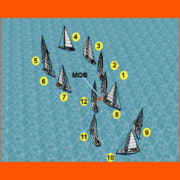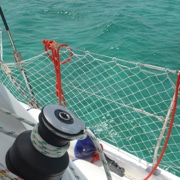Poison Prevention Week: Hidden Hazards in the Hull
National Poison Prevention Week is the third week of March each year, falling on the 17th through the 23rd this year. This cause was founded by the Health Research & Safety Administration to raise awareness for preventative methods to avoid toxic poisons. The week of awareness is a chance to feature various hazards that result in dangerous poisonings, and how to combat them. Whether you’re an avid sailor or a part-time hobbyist, there are several situations specific to boating that can present poison hazards to your health. Simple and mindful education can inform enthusiasts on the ways to maintain their well-being.
Across all ages, 77% of poison exposures reported to U.S. poison centers in 2017 were unintentional. According to the CDC, unintentional poisoning is the leading cause of injury death for all age groups.
Unintentional poisoning has surpassed motor vehicle traffic deaths as the leading cause of injury fatalities in the U.S. since 2008.
The U.S. Coast Guard’s report on 2017 Recreational Boating Statistics revealed that carbon monoxide poisoning ranks fifth in the top known causes of death among boaters, and is the most common cause of illness and death by poisoning in boaters.
Potential Sailboat Toxins:
Fumes or Chemicals:
Carbon Monoxide (CO) is a poisonous gas that you can’t see, smell or taste. It’s produced when carbon-based fuels, such as gasoline and propane, are burned. Carbon monoxide is one of the most dangerous poisons on the water because often boaters won’t notice the presence until unsettling symptoms onset.
Potential Sources of CO in Boats:
- Engines
- Generators
- Space and water heaters
- Cooking ranges
- Blocked ventilation louvers and exhaust outlets
- Dock, anchor, or raft in close range of engines/generator exhaust for lengthy times
Oftentimes, the amount of carbon monoxide normally produced by common sources presents no concern for bodily harm. It is improper installation, poor ventilation or enclosed spaces that can lead to carbon monoxide levels climbing to dangerous rates. Too much carbon monoxide in the air can result in this poison entering the bloodstream by way of the lungs. After reaching the bloodstream, CO leaves no room for the oxygen your body requires, leading to serious organ damage and death. Early symptoms include an increased heart rate, loss of consciousness and seizures.
Asbestos:
Due to the versatility of use and inexpensive application, asbestos was widely used across the globe as a building material up until the 1980s. Asbestos is a fibrous mineral that became a common additive for marine paneling due to the mineral’s high resistance to heat and water. Asbestos was an obvious addition to marine products seeing how fire and floods are detrimental to any watercraft. It is important to note that asbestos is not a hazard when fully intact or undisturbed but becomes a health hazard when inhaled. If you find yourself performing work on any boat it is important to understand the places this poisonous fiber may be hiding. Exposure to asbestos is directly linked to the notoriously aggressive mesothelioma cancer.
Where asbestos is potentially found:
- Various adhesives
- Marine panel linings
- Cauk, various compounds
- Sealants, epoxies, resins
- Cement, Putty
- Engine gaskets, heat seals
- Electrical insulation
- Hull and Cuddy Insulation
On board a boat, large or small, asbestos is most commonly discovered in highest concentrations within a variety of marine panels. This paneling is often used as enclosed lining or for partitions, essentially strengthening the body of a vessel. Asbestos exposure is most commonly associated with larger maritime vessels, including navy ships. Unfortunately, the toxin can be present on a variety of recreational boats, especially ones dated before the 1980s.
Harmful Algae Blooms (HAB):
Toxic algae refers to a specific type of algae that can exist in different forms across lakes, oceans, and streams. Depending on geographical location this environmental poison is commonly referred to as red tide, blue-green algae, or cyanobacteria. Algal blooms are increasingly becoming a serious environmental concern across all 50 states. Although this toxin occurs naturally and often in non-toxic forms, it can be poisonous. The rapid growth of algae is caused by an excess of nutrients (particularly phosphorus and nitrogen) in the water. Human and industrial wastes contribute to these HAB nutrients. Too much algae creates sea-life dead zones in the water while also halting areas of tourism or water-dependent industries. HAB is a serious health hazard to humans, pets, and marine life alike. Blooms can be seen as a cloudy sludge in the water, the algae will begin to rise and can travel with currents. Depending on the species of algae, these blooms can have severe impacts on human health if accidentally ingested.
Poisons can be prevalent in even the most comfortable of places, so caution is key. Prevention and awareness are the best routes to avoid mistakenly coming into contact with a harmful substance. Before you work on your watercraft or perform any general maintenance or DIY projects that could include power tools, always consider the toxins hidden below the deck.
Article written by Dylan Hendrix who works for Mesothelioma Cancer Alliance and is a NauticEd student. Dylan wanted to contribute this article in light of National Poison Prevention Week. Thanks to Dylan for this awareness.





